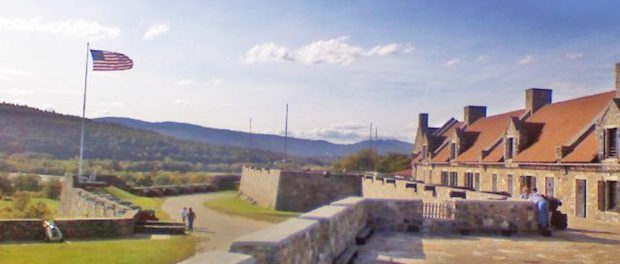1759: The Other Ticonderoga & Other Quebec Curios
Part of “Je me souviens: New France, 1534–1763”
On the heels of the massive failure that was the Battle of Ticonderoga/Carillon, the British had a victory in the Battle of Ticonderoga. The British, wanting to claim Fort Carillon for themselves once again, launched another attack of the fort, this time headed by the more competent general, Jeffrey Amherst. (Remember this man’s name—he will come up once again after the Conquest.) Unlike Abercrombie’s battle planning and defences (or lack thereof), Amherst brought in the heavy artillery in order to attack the French fort. Montcalm, who had since been moved elsewhere after the Battle of Carillon and another dispute with General Vaudreuil, left the fort under the charge of François-Charles de Bourlamaque, who had participated in the Battle of Carillon. Bourlamaque decided that, instead of risking a battle with British cannons, it would be good to go out with a bang rather than a whimper. Under orders from Montcalm and Vaudreuil, who were in agreement for once, told Bourlamaque to do just that—abandon the fort and attempt to blow it up. As Amherst and the British arrived, Louis-Philippe d’Hébécourt, the unlucky man left to man the fort after Bourlamaque’s departure, as well as a few hundred that had stayed as well, lit a trail of powder that would blow up the ammunition storeroom and left, leaving the French flag flying proudly.
The British, informed of this action, attempted to pay people to put out the fire, but naturally, nobody wanted to risk their lives and step forward. The fire was eventually extinguished a couple of days after it started, and though some of the interior of the fort was destroyed, almost miraculously, the fort’s star-shaped walls were mostly preserved. The British moved in, did the necessary repairs, and renamed the fort Ticonderoga, after the Iroquois word that meant “where two waters meet”. The fort would later serve as an important early victory for the rebel Revolutionaries in the American War of Independence less than a couple of decades later.
While the French lost Fort Carillon the second time around, it was around this time that the French had an important victory in the city of Beauport in New France. Two military leaders, James Wolfe and Louis-Joseph Montcalm, would confront each other in a battle that would force a British retreat after a rainstorm started, rendering any firearm unusable due to wet gunpowder. Wolfe and Montcalm would meet in battle once more that year, only nine kilometres from where they last met, and this time their encounter with each of their respective armies would prove fatal for both of them. The Battle on the Plains of Abraham, also called the Battle of Quebec, would last only fifteen minutes, but as a consequence, it would also set the clock ticking for New France.
While Fort Ticonderoga unfortunately fades out of Quebec Curios’ view for now, you can still learn all about the fort here.






